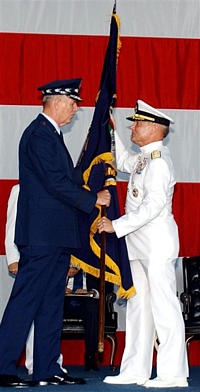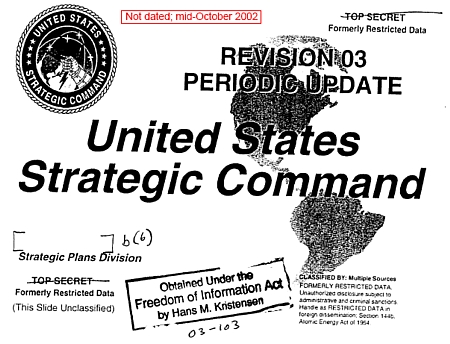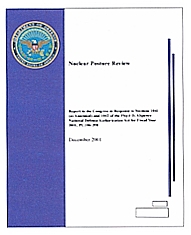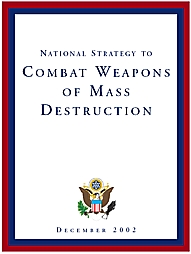White House Guidance Led to New Nuclear Strike Plans Against Proliferators, Document Shows
By Hans M. Kristensen
The 2001 Nuclear Posture Review (NPR) and White House guidance issued in response to the terrorist attacks against the United States in September 2001 led to the creation of new nuclear strike options against regional states seeking to acquire weapons of mass destruction, according to a military planning document obtained by the Federation of American Scientists.
Rumors about such options have existed for years, but the document is the first authoritative evidence that fear of weapons of mass destruction attacks from outside Russia and China caused the Bush administration to broaden U.S. nuclear targeting policy by ordering the military to prepare a series of new options for nuclear strikes against regional proliferators.
Responding to nuclear weapons planning guidance issued by the White House shortly after the terrorist attacks on September 11, 2001, U.S. Strategic Command created a series of scenario driven nuclear strike options against regional states. Illustrations in the document identify the states as North Korea and Libya as well as SCUD-equipped countries that appear to include Iran, Iraq (at the time), and Syria – the very countries mentioned in the NPR. The new strike options were incorporated into the strategic nuclear war plan that entered into effect on March 1, 2003.
The creation of the new strike options contradict statements by government officials who have insisted that the NPR did not change U.S. nuclear policy but decreased the role of nuclear weapons.
Non-Denial Denials and a Few Hints
When portions of the 2001 Nuclear Posture Review (NPR) were leaked in the Los Angeles Times in March 2002, government officials responded by playing down the importance of the document and its effect on nuclear planning. And officials have since continue to credit the NPR with reducing the reliance on nuclear weapons.
The NPR is “not a plan, it’s not an operational plan,” then Chairman of the Joint Chiefs of Staff General Richard B. Myers insisted on CNN the day after the NPR was leaked. “It’s a policy document. And it simply states our deterrence posture, of which nuclear weapons are a part….And it’s been the policy of this country for a long time, as long as I’ve been a senior officer, that the president would always reserve the right up to and including the use of nuclear weapons if that was appropriate. So that continues to be the policy.”
A formal statement published by the Department of Defense added that the NPR “does not provide operational guidance on nuclear targeting or planning,” but that the military simply “continues to plan for a broad range of contingencies and unforeseen threats to the United States and its allies.”
Most recently, on October 9, 2007, Christina Rocca, the U.S. permanent representative to the Conference on Disarmament, told the First Committee of the U.N. General Assembly that the United States has been “reducing the…degree of reliance on [nuclear] weapons in national security strategies….It was precisely the new thinking embodied in the NPR that allowed for the historic reductions we are continuing today.”
Yet a few officials hinted in 2002 that the same guidance expanded nuclear planning. “There are nations out there developing weapons of mass destruction,” then Secretary of State Colin Powell said on CBS’ Face the Nation. “Prudent planners have to give some consideration as to the range of options the president should have available to him to deal with these kinds of threat,” he said.
The declassified U.S. Strategic Command (STRATCOM) document shows that one of the first results of “the new thinking” of the NPR was the creation of a series of new nuclear strike options against regional states.
A Series of Regional Options
The 26-page declassified document, an excerpt from a 123-page STRATCOM briefing on the production of the 2003 strategic nuclear war plan known as OPLAN 8044 Revision 03, includes two slides that describe the planning against “regional states.” The first of these slides lists a “series of [deleted] options” directed against regional countries with weapons of mass destruction programs. The planning is “scenario driven,” according to the document. The majority of the document deals with targeting of Russia and China, but virtually all of those sections were withheld by the declassification officer.
The names of the “regional states” were also withheld, but three images used to illustrate the planning were released, and they leave little doubt who the regional states are: One of the images is the North Korean Taepo Dong 1 missile; another image shows the Libyan underground facility at Tarhuna; and the third image shows a SCUD B short-range ballistic missile. The SCUD B image is not country-specific, but the Air Force National Air and Space Intelligence Center report Ballistic and Cruise Missile Threat from 2003 listed 12 countries with SCUD B missiles: Belarus, Bulgaria, Egypt, Iran, Kazakhstan, Libya, North Korea, Syria, Turkmenistan, Ukraine, Vietnam and Yemen. Five of these were listed in the NPR as examples of countries that were “immediate, potential, or unexpected contingencies…setting requirements for nuclear strike capabilities”: Iran, Iraq, Libya, North Korea and Syria.
 |
|
Images included in the declassified STRATCOM document identify several regional states as targets for new nuclear strike plans. |
The inclusion of regional nuclear counterproliferaiton strike options into the national (strategic) war plan is a new development because such scenarios have normally been thought to reside at a lower level than the national strategic plan, which has traditionally been focused on targeting of Russia and China. During the 1990s, STRATCOM developed adaptive planning capabilities that enabled quick production of strikes against “rogue” states if necessary, but “there were no immediate plans on the shelf for target packages to give to bombers or missile crews,” a former senior Pentagon official told Washington Post in 2002. OPLAN 8044 Revision 03 changed that by producing executable strike options to the nuclear forces.
The “target base” for the regional states is outlined in the STRATCOM document, but everything except the title has been withheld. But the target base probably included weapons of mass destruction, deep, hardened bunkers containing chemical or biological weapons, or the command and control infrastructure required for the states to execute a WMD attack against the United States or its friends and allies. The U.S. Nuclear Weapons Employment Policy (NUWEP) that entered into effect one year after OPLAN 8044 Revision 03 stated in part: “U.S. nuclear forces must be capable of, and be seen to be capable of, destroying those critical war-making and war-supporting assets and capabilities that a potential enemy leadership values most and that it would rely on to achieve its own objectives in a post-war world.”
The creation of a “target base” indicates that the planning went further than simple retaliatory punishment with one or a few weapons, but envisioned actual nuclear warfighting intended to annihilate a wide range of facilities in order to deprive the states the ability to launch and fight with WMD. The new plan formally broadened strategic nuclear targeting from two adversaries (Russia and China) to a total of seven.
Iraq presumably disappeared from the war plan again after U.S. forces invaded the country in March 2003 – only three weeks after OPLAN 8044 Revision 03 went into effect – and discovered that Iraq did not have weapons of mass destruction. Libya presumably disappeared after December 2003, when President Muammar Gaddafi declared that he was giving up efforts to develop weapons of mass destruction.
The nuclear strike plans against Iran, North Korea and Syria, however, presumably were carried forward into the next OPLAN 8044 Revision 05 from October 2004, a plan that was still in effect as recently as July 2007.
|
Nuclear Guidance |
|
|
|
|
| “The 2001 Nuclear Posture Review (top) and White House guidance led to an expansion of U.S. nuclear targeting plans. |
New Guidance for the Regions
The STRATCOM document indicates that National Security Presidential Directive (NSPD)-14 signed by President Bush on June 28, 2002, was the key While House guidance that resulted in the incorporation into the strategic nuclear war plan of strike options against regional proliferators.
Very little has been disclosed about NSPD-14, except that it laid out Presidential nuclear weapons planning guidance and provided broad overarching directions to the agencies and commands for nuclear weapon planning. As such, NSPD-14 might have been replacing Presidential Decision Directive (PDD)-60 signed by President Clinton in November 1997 as the primary White House guidance for nuclear weapons planning. PDD-60 reportedly also required planning against proliferators, but the new strike options incorporated into Revision 03 were “notable changes” compared with the previous plan, according to the STRATCOM document.
Flowing from NSPD-14 were several other important guidance documents that deepened the commitment to targeting regional proliferators. The first was the JSCP Transitional Guidance in June 2002, which directed changes to the Joint Strategic Capabilities Plan (JSCP). JSCP includes a nuclear annex or supplement, known as JSCP-N, that give detailed nuclear planning guidance to the unified and regional commanders. The new JSCP-N was published on October 1, 2002. Another document was the NUWEP (Nuclear Weapons Employment Policy) Transitional Guidance signed on August 29, 2002, which led to the publication of NUWEP-04 in April 2004.
Three months after NSPD-14, on September 14, 2002, President Bush also signed NSPD-17 (National Strategy to Combat Weapons of Mass Destruction), a directive that articulated a comprehensive strategy to counter nuclear and other weapons of mass destruction. NSPD-17 reaffirmed that, if necessary, the United States will use nuclear weapons against anyone using weapons of mass destruction against the United States, its forces abroad, and friends and allies, according to Washington Times. But a top-secret appendix to NSPD 17 specifically named Iran, Syria, North Korea and Libya as being among the countries that are the central focus of the new strategy, and that options included nuclear weapons. Those options were in place with OPLAN 8044 Revision 03. The motivation for the new strategy, one participant in the interagency process that drafted it told Washington Post, was the conclusion that “traditional nonproliferation has failed, and now we’re going into active interdiction.” NSPD-17 is sometimes also called the preemption doctrine.
The regional strike plans also found their way into the draft Doctrine for Joint Nuclear Operations (Joint Publication 3-12), which was under preparation within the military at the time Revision 03 was created. Yet the doctrine showed that planning went beyond retaliation and included preemptive strikes. The second draft from March 2005 listed five scenarios where use of nuclear weapons might be requested:
• To counter an adversary intending to use weapons of mass destruction against U.S., multinational, or allies forces or civilian populations;
• To counter an imminent attack from an adversary’s biological weapons that only effects from nuclear weapons can safely destroy;
• To attack on adversary installations including weapons of mass destruction, deep, hardened bunkers containing chemical or biological weapons, or the command and control infrastructure required for the adversary to execute a WMD attack against the United States or its friends and allies; [this was probably the “target base” in OPLAN 8044 Revision 03]
• To counter potentially overwhelming adversary conventional forces;
• To demonstrate U.S. intent and capability to use nuclear weapons to deter adversary WMD use.
After I disclosed this development in an article in Arms Control Today in September 2005 and the Washington Post followed up with a front-page story, sixteen members of Congress – including the current chair of the House Armed Services Committee – reacted by writing to the president to object to what they considered to be a “drastic shift in U.S. nuclear policy.”
Embarrassed by the exposure, the Pentagon canceled not only the draft doctrine (and four other related doctrine documents) but also the existing Doctrine for Joint Nuclear Operations document that had been publicly available on the Joint Chiefs of Staff web site for a decade. A Joint Staff official explained that the documents would not be published, revised or classified, explaining that that they had been found not to be real doctrine documents but “pseudo doctrine” documents discussing nuclear policy issues. The public “visibility led a lot of people to question why we have them,” he said.
|
|
 |
|
During the tenure of Admiral Ellis (right), STRATCOM prepared, and CJCS Richard Myers (left) approved, an expansion of the SIOP to “a family of plans applicable in a wider range of scenarios.” |
From SIOP to OPLAN 8044: A “Family of Plans”
There is no indication that cancelation of the Doctrine for Joint Nuclear Operations documents changed nuclear policy. The declassified STRATCOM document describes OPLAN 8044 Revision 03 as “a transitional step toward the new TRIAD and future war plans.” That transition began long before the “New Triad” phrase was coined by the 2001 NPR, and has gradually transformed the top-heavy self-standing Single Integrated Operational Plan (SIOP) to a broader set of strike options applicable in a wider range of scenarios against more adversaries. When preparation of Revision 03 began in March 2002, the combat employment portion of the strategic nuclear war plan was still known as the SIOP, but the name had to be changed to reflect the emerging multitude of strike options.
As the Joint Staff started to review the new war plan, STRATCOM commander Admiral James Ellis wrote to General Myers that the name SIOP did not properly describe the new plan. “STRATCOM is changing the nation’s nuclear war plan from a single, large, integrated plan to a family of plans applicable in a wider range of scenarios,” Ellis explained with a reference to Revision 03. The first STRATCOM commander, General George Lee Butler, had tried to change the name in 1992, but with no luck. Butler wanted to change the name to National Strategic Response Plans. Eleven years later, Admiral Ellis tried again. The SIOP name, he said, was a Cold War legacy.
This time, the JCS chairman was more receptive. On February 8, 2003, only one month before Revision 03 went into effect, General Myers authorized STRATCOM to formally change the name to reflect the creation the “new family of plans.” Yet Myers was concerned that confusion might arise “between the basic USSTRATCOM OPLAN 8044 and the combat employment portion of that OPLAN, currently known as the SIOP.” The solution, he decided, was to continue to call the basic plan OPLAN 8044, but incorporate the term OPLAN 8044 Revision (FY) to describe that portion of the plan currently known as the SIOP. The Revision number (FY) would correspond to the fiscal year the combat employment plan was put into effect. OPLAN 8044 Revision 03 of March 1, 2003, was the first plan to carry the new name.
The new strike options apparently were carried forward into OPLAN 8044 Revision 05, the next strategic war plan that entered into effect on October 1, 2004. This plan was described as a “major revamping” of the U.S. strategic war plan, which, according to General Myers, “provides more flexible options to assure allies, and dissuade, deter, and if necessary, defeat adversaries in a wider range of contingencies.” OPLAN 8044 Revision 05 was still in effect as of July 2007 (for a chronology of U.S. nuclear guidance and war plans under the Bush administration, go here).
Claims About Reducing Reliance On Nuclear Weapons
Officials frequently credit the NPR with having significantly reduced the reliance on nuclear weapons in U.S. nuclear policy. The basis for this claim is that non-nuclear capabilities also should play a role in deterring potential adversaries, an goal exemplified by the incorporation of conventional strike options into OPLAN 8044 Revision 05, the war plan than followed OPLAN 8044 Revision 03, and the removal of Russia as an “immediate contingency.”
“The United States has set in motion an entirely new way of looking at the role of nuclear weapons in our defense strategy,” Jackie W. Sanders, U.S. Ambassador and Special Representative of the President for the Nonproliferation of Nuclear Weapons, told the 2005 Nonproliferation Treaty Review Conference. “I speak, Mr. Chairman, of the U.S. Nuclear Posture Review, or NPR, of 2001. The United States has undertaken reviews of this sort in the past, but the 2001 NPR is unique, and fully consistent with Article VI. The 2001 NPR established a New Triad of strategic capabilities, one that places far less reliance on nuclear weapons to meet U.S. defense policy goals…. Let me emphasize, Mr. Chairman, that the New Triad concept resulting from the NPR, in principle and in practice, will reduce reliance on nuclear weapons in U.S. national security strategy. It reflects a totally new vision of the future, and is fully consistent with our indisputable resolve to implement Article VI.”
But while some conventional weapons are being incorporated into the national war plan and planning against Russia is not done in the same way it was during the Cold War, the NPR (building on the 1997 PDD-60) and White House guidance also resulted in an increased nuclear targeting of China and, as the declassified STRATCOM document illustrates, an geographic expansion of national-level nuclear targeting to regional proliferators. Prudent or not, this is not a development that is highlighted by U.S. diplomats at NPT conferences.
Description of Document
The declassified document is heavily redacted and consists of 26 of a total of 123 slides from the Revision 03 Periodic Update of the U.S. strategic war plan that went into effect on March 1, 2003. The plan was the first strategic war plan to carry the new name Operations Plan (OPLAN) 8044 Revision 03, which replaced the Single Operational Strategic Plan (SIOP) name used since 1960. OPLAN 8044 Revision 03 replaced SIOP-03 from October 1, 2002.
The document describes six parts of the new plan preparation: Revision 03 production status, planning guidance, target base, committed forces, options, and conclusions.
The document is not dated, but appears to be from October 2002, shortly before the Secretary of Defense was briefed. Targeting intelligence and selection had been completed, warheads allocated to the strike plans, and strike (sortie) planning for Intercontinental Ballistic Missiles (ICBMs), Sea-Launched Ballistic Missiles (SLBMs), and long-range bombers nearly completed. After a Joint Staff review and production of the final Revision Report 03 in January 2003, final Defense Secretary review and approval by the Chairman of the Joint Chiefs of Staff were scheduled for late January 2003 before OPLAN 8044 Revision 03 went into effect on March 1, 2003.
Declassification of the document took four years. It was released in response to a FOIA request submitted in October 2003 for documents pursuant to remarks made by then Chairman of the Joint Chiefs of Staff General Richard Myers during a Senate Foreign Relations Committee Hearing in July 2002. When asked if there had been a review of the SIOP since the mid-1990s, Myers replied: “Yes, there absolutely has. In fact, the secretary and I spent considerable time revising the SIOP. I think we started that last year and have gotten another major review ongoing.” The declassified document was released on October 10, 2007.
Resources: U.S. Nuclear Weapons Guidance | The Matrix of Deterrence | The Post Cold War SIOP and Nuclear Warfare Planning: A Glossary, Abbreviations, and Acronyms
Acknowledgements: This research has been made possible by support from the Ford Foundation, the John D. and Catherine T. MacArthur Foundation, and the Ploughshares Fund.
The FY2026 National Defense Authorization Act (NDAA) paints a picture of a Congress that is working to both protect and accelerate nuclear modernization programs while simultaneously lacking trust in the Pentagon and the Department of Energy to execute them.
While advanced Chinese language proficiency and cultural familiarity remain irreplaceable skills, they are neither necessary nor sufficient for successful open-source analysis on China’s nuclear forces.
Satellite imagery has long served as a tool for observing on-the-ground activity worldwide, and offers especially valuable insights into the operation, development, and physical features related to nuclear technology.
This report outlines a framework relying on “Cooperative Technical Means” for effective arms control verification based on remote sensing, avoiding on-site inspections but maintaining a level of transparency that allows for immediate detection of changes in nuclear posture or a significant build-up above agreed limits.


